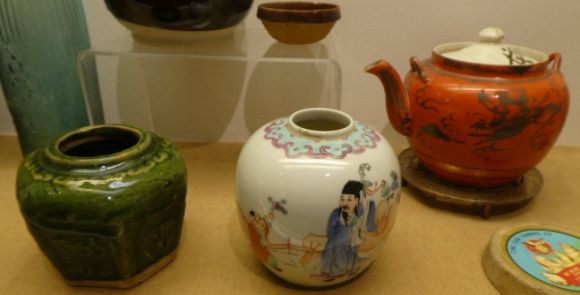Fort Steele, British Columbia, flourished in the 1890s, and then began to decline when the railroad by-passed the town in 1898. Today Fort Steele is a Heritage Village in which visitors can experience what life was like in the 1890s. The Heritage Village includes restored buildings, replica buildings, and buildings which are allowed to decay naturally. The Fort Steele Heritage Town Museum is located in the second floor of the replica of the Wasa Hotel. One of the displays in the museum looks at the Chinese in British Columbia.
Many of the first Chinese to come to British Columbia came from the United States, particularly California. Like other immigrants, they were looking for new opportunities.
According to the display:
“The initial reason for allowing Chinese immigration to the west was purely utilitarian: they were not meant to be settlers per se, but rather cheap labour. As the name of the province suggests, British Columbia was envisioned as an outpost of Britain, not as the mosaic it had now become. The Victorian Era made use of class distinctions which may shock some people today.”

In the late nineteenth century, coal was the primary energy and heating source. The coal mines in British Columbia required miners to work them. In order to make the mines more profitable, Chinese labor was recruited in part because they weren’t citizens and thus didn’t have the right to organize for better wages and working conditions. This meant that they were far more affordable for the mine owners.
In addition to working in the coal mines, some Chinese sought to find riches by searching for gold in the mountains of British Columbia.



 Shown above are some early twentieth century drug paraphernalia.
Shown above are some early twentieth century drug paraphernalia.
According to the display:
“As is all-too-often the case for many hard-pressed working-class men, drugs were used as a coping mechanism for many Chinese labourers. The most common of these amongst the Chinese was opium. Although originally used in private, the demand for the drug facilitated the creation of opium dens which, again, became an economic pillar in the Chinese-Canadian community. Opium dens were opened as sort of primitive spas/pubs in which a tired workman could lay down and smoke (actually, vapourise) opium tablets.”





Museums 101
History museums provide a window into the past and helps us understand life in the past. Museums 101 is a series of photo tours of different museum exhibits. Also from this series:
Museums 101: Mai Wah, the Chinese Experience in Butte, Montana (Photo Diary)
Museums 101: The Wah Chong Tai Merchantile (Photo Diary)
Museums 101: The Dalles Chinatown (Photo Diary)
Museums 101: Horse-Drawn Wagons in Fort Steele (Photo Diary)
Museums 101: Some Farm Equipment at Fort Steele (Photo Diary)
Museums 101: The Churches of Fort Steele (Photo Diary)
Museums 101: The Cheap Cash Store (Photo Diary)
Museums 101: A Cabinet of Curiosities (Photo Diary)


